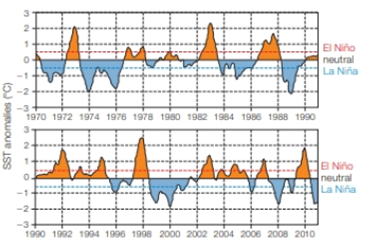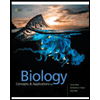
Concept explainers
Sea Temperature To predict the effect of El Niño or La Niña events in the future, the National Oceanographic and Atmospheric Administration collects information about sea surface temperature (SST) and atmospheric conditions. They compare monthly temperature averages in the eastern equatorial Pacific Ocean to historical data and calculate the difference (the degree of anomaly) to determine if El Niño conditions, La Niña conditions, or neutral conditions are developing. El Niño is a rise in the average SST above 0.5°C. A decline of the same amount is La Niña. FIGURE 47.8 shows data for 42 years.

FIGURE 47.8 Sea surface temperature anomalies (difference from the historical mean) in the eastern equatorial Pacific Ocean. A rise above the dashed red line is an El Niño event, a decline below the blue line is La Niña
When did the greatest positive temperature deviation occur during this time period?
To determine: The greatest positive temperature deviation.
Concept introduction: EI Nino Southern Oscillation (ENSO) event is an interaction between the ocean-atmosphere climates, during which irregular temperature fluctuation occurs in the equatorial Pacific Oceans. EI Nino and La Nina are the two extremes of this EI Nino Southern Oscillation. During an EI Nino, warm water flows towards the west coast of South America and during a LA Nina, cold water flows towards the western coast of South America. At other time, water of the Pacific is neutral.
Explanation of Solution
The National Oceanographic and Atmospheric Administration collect information regarding sea surface temperature (SST) and different atmospheric conditions to monitor and to observe if climatic events coordinate with the events of EI Nino, La Nina, or just neutral in the future. For this purpose, they compare monthly average temperature with the historical data in the equatorial Pacific Oceans. They estimate the difference to determine the different conditions that are developing, whether an EI Nino conditions, La Nina conditions, or normal conditions.
Refer to the Fig. 47.8 “Sea surface temperature anomalies (difference from the historical mean) in the equatorial Pacific Ocean” in the textbook. It shows that an EI Nino rises above the SST that is above the dashed red line and a La Nina declines below the SST that is below the dashed blue line. In the year 1998, the greatest positive temperature deviation occurred. EI Nino rises in the average SST above 2.5°C.
During the year 1998, the greatest positive temperature deviation occurred.
Want to see more full solutions like this?
Chapter 47 Solutions
Biology: The Unity and Diversity of Life (MindTap Course List)
Additional Science Textbook Solutions
Human Physiology: An Integrated Approach (8th Edition)
Biological Science
Human Anatomy & Physiology (2nd Edition)
Principles of Anatomy and Physiology
Fundamentals of Anatomy & Physiology Plus Mastering A&P with eText - Access Card Package (10th Edition) (New A&P Titles by Ric Martini and Judi Nath)
Genetics: From Genes to Genomes
- Climate is the result of a variety of global processes. What of the following is a climatological driver? rotation of Earth hydrosphere properties oceanic currents concertation of sun irradiances all of the abovearrow_forwardPredictions of hydroclimatic change with global warming suggest that precipitation events are becoming/will become more extreme. In other words, heavy/flooding precipitation events will occur with greater frequency. Explain how the capacity of Earth’s atmosphere to hold water vapor changes as the atmosphere warms, such that heavier precipitation events could be triggered.arrow_forwardWhich of the following statements about atmospheric carbon dioxide levels is correct? For about 800,000 years prior to human influence it varied between 180 and 300 ppm and is now above 410 ppm. For about 800,000 years prior to human influence it never exceeded 200 ppm. Its rate of increase in the past century is greater than any seen in the ice core record. Both 1 & 3arrow_forward
- What pieces of evidence are presented that prove or reinforce the connection between climate change and the changing meteorological pattern? Answer: • Rising global temperatures (EXPLANATION) • Changes in extreme weather event (EXPLANATION) • Changes in atmospheric and oceanic circulation patterns (EXPLANATION) • Changes in precipitation patterns (EXPLANATION) • Rising sea levels (EXPLANATION) I need explanation only, thanksarrow_forwardThere is growing support for the idea that as we warm the planet and spread fresh water over the North Atlantic from melting polar ice caps in the Arctic, we will slow down the conveyor belt circulation. What might happen to temperatures at: High Latitudes: At Mid and Low Latitudes:arrow_forwardWhich of the following statements explains why temperature is considered a reliable metric to investigate climate change? Select all that apply: a. changes in other aspects of climate, such as precipitation or sea level, are a response to the temperature change b. there is a long-term global database for temperature c. temperature has been measured directly for millennia d. global temperature measurements include weather variabilityarrow_forward
- Alabama isn't a desert! Yet, it is at the same latitude as most major deserts in the Northern Hemisphere. What major feature on the earth is responsible for Alabama's humid climate? Group of answer choices hadley cells tradewinds ocean gyres ground waterarrow_forwardWhich of the following statements is TRUE about the factors that shape regional climates? can choose more than one answer Group of answer choices Riverside has high variation in daily and seasonal temperatures because it exhibits a maritime climate. The rain-shadow effect explains why climates on both sides of a mountain are moist. Areas that are near the center of large continents have greater variation in temperature than areas that are near the coast.arrow_forwardIf the global average temperature on Earth were to drop 6°C below the current value, what conditions would you expect to see on Earth? Select all that apply: a. sea ice would be present throughout earth, even in the tropics b. sea level would be 10 meters lower than it is now c. glaciers would extend to mid-latitudes, particularly in the northern hemisphere d. sea level would drop significantly and be a few hundred feet lower than it is now e. the albedo would decrease as snow and ice expand globallyarrow_forward
- Select the correct terms: (Climate / Weather) is the short-term atmospheric conditions in an area, while (climate / weather) is the average atmospheric conditions in a given area over a long period of time. (Climate change / Global warming) consists of the long-term and largescale changes in atmospheric conditions, which have been brought about by (climate change / global warming), an increase in the average global temperature.arrow_forwardHuman lifestyle choices currently release greenhouse gases into the atmosphere at higher rates than what occurs naturally. When greenhouse gases like carbon dioxide, methane, and nitrous oxide accumulate they trap heat. As a result of this trapped heat, temperatures on Earth's surface are changing Figure 1 - Greenhouse Gas Emissions by Humans Choice and the Greenhouse Gases Emitted as a Result Which of these ideas would be the best course of action for decreasing land temperatures? 1. Phase-out agricultural production, since that sector, produces the largest amounts of methane and nitrous oxide. 2. Decrease land use and biomass burning, because this sector produces all three major greenhouse gases. 3. increase the number of waste disposal and treatment plants because they do not release carbon dioxide 4. Develop alternative energy sources to decrease the amount of carbon dioxide released as a result of power stationsarrow_forwardThe warming trends discussed in the Case Study are most pronounced at the equator, where sunlight is most direct. What would you predict the effect of global warming to be nearer the poles, where temperatures are lower and there is less sunlight?arrow_forward
 Biology: The Unity and Diversity of Life (MindTap...BiologyISBN:9781305073951Author:Cecie Starr, Ralph Taggart, Christine Evers, Lisa StarrPublisher:Cengage Learning
Biology: The Unity and Diversity of Life (MindTap...BiologyISBN:9781305073951Author:Cecie Starr, Ralph Taggart, Christine Evers, Lisa StarrPublisher:Cengage Learning Biology: The Unity and Diversity of Life (MindTap...BiologyISBN:9781337408332Author:Cecie Starr, Ralph Taggart, Christine Evers, Lisa StarrPublisher:Cengage Learning
Biology: The Unity and Diversity of Life (MindTap...BiologyISBN:9781337408332Author:Cecie Starr, Ralph Taggart, Christine Evers, Lisa StarrPublisher:Cengage Learning Biology Today and Tomorrow without Physiology (Mi...BiologyISBN:9781305117396Author:Cecie Starr, Christine Evers, Lisa StarrPublisher:Cengage Learning
Biology Today and Tomorrow without Physiology (Mi...BiologyISBN:9781305117396Author:Cecie Starr, Christine Evers, Lisa StarrPublisher:Cengage Learning Biology: The Dynamic Science (MindTap Course List)BiologyISBN:9781305389892Author:Peter J. Russell, Paul E. Hertz, Beverly McMillanPublisher:Cengage Learning
Biology: The Dynamic Science (MindTap Course List)BiologyISBN:9781305389892Author:Peter J. Russell, Paul E. Hertz, Beverly McMillanPublisher:Cengage Learning




